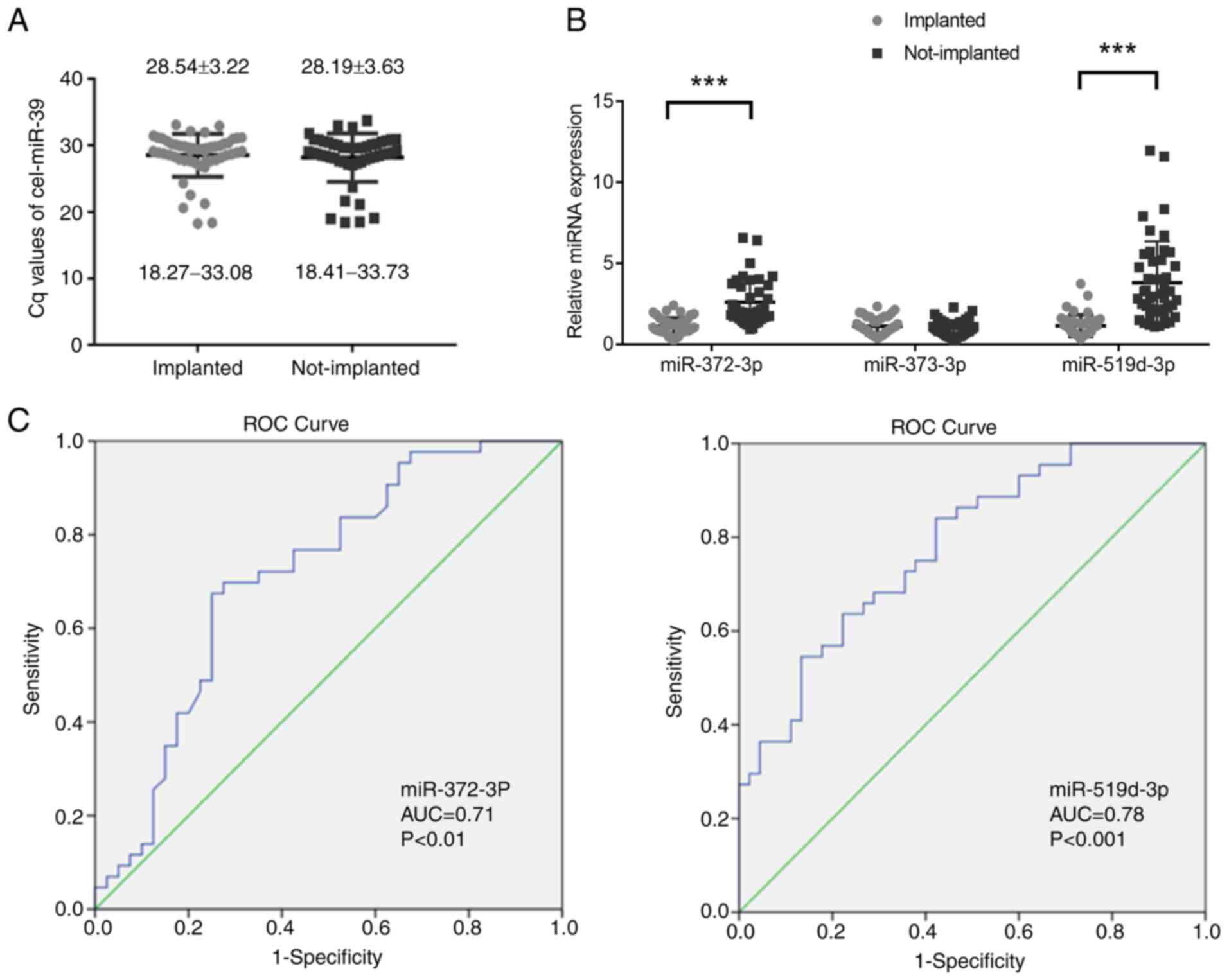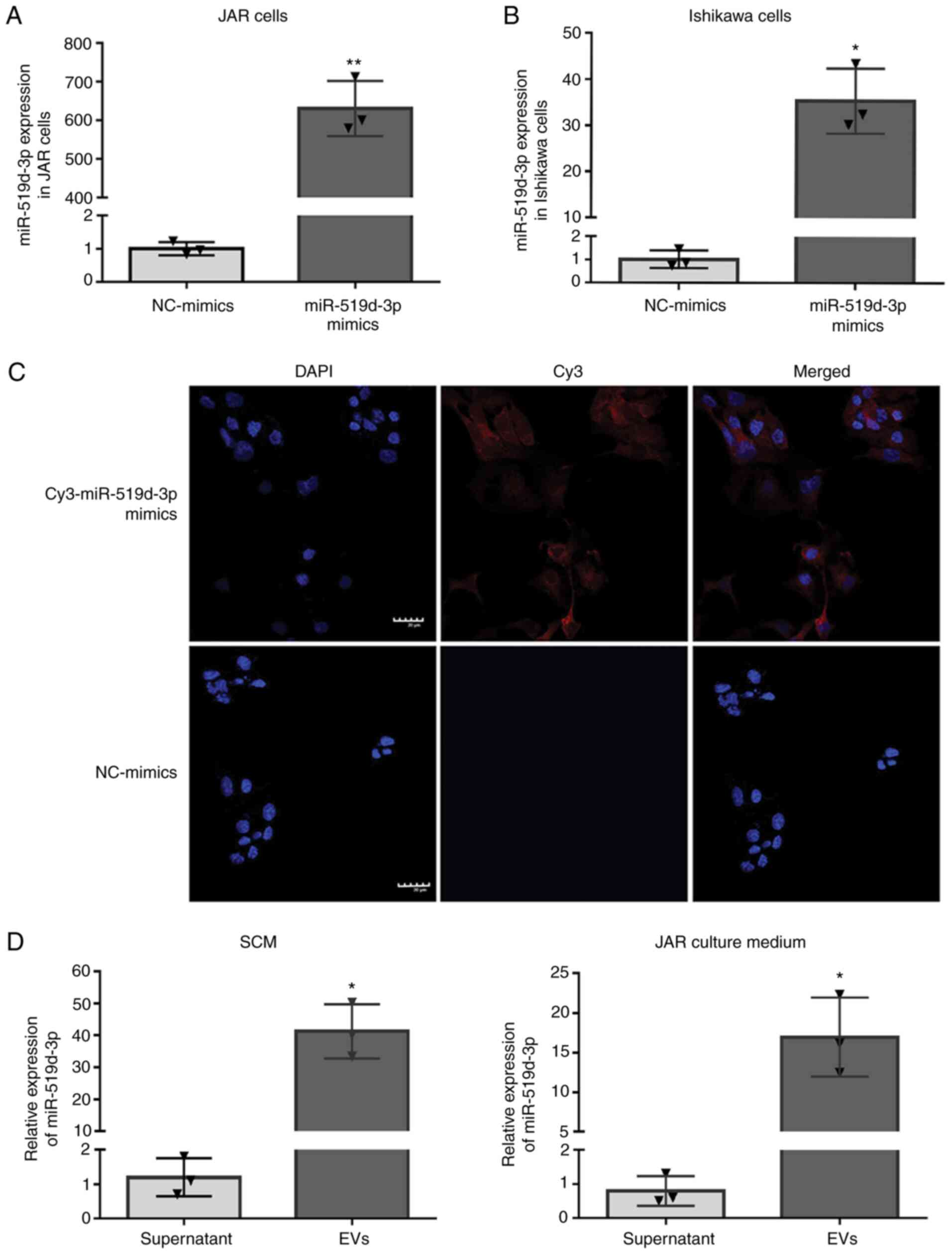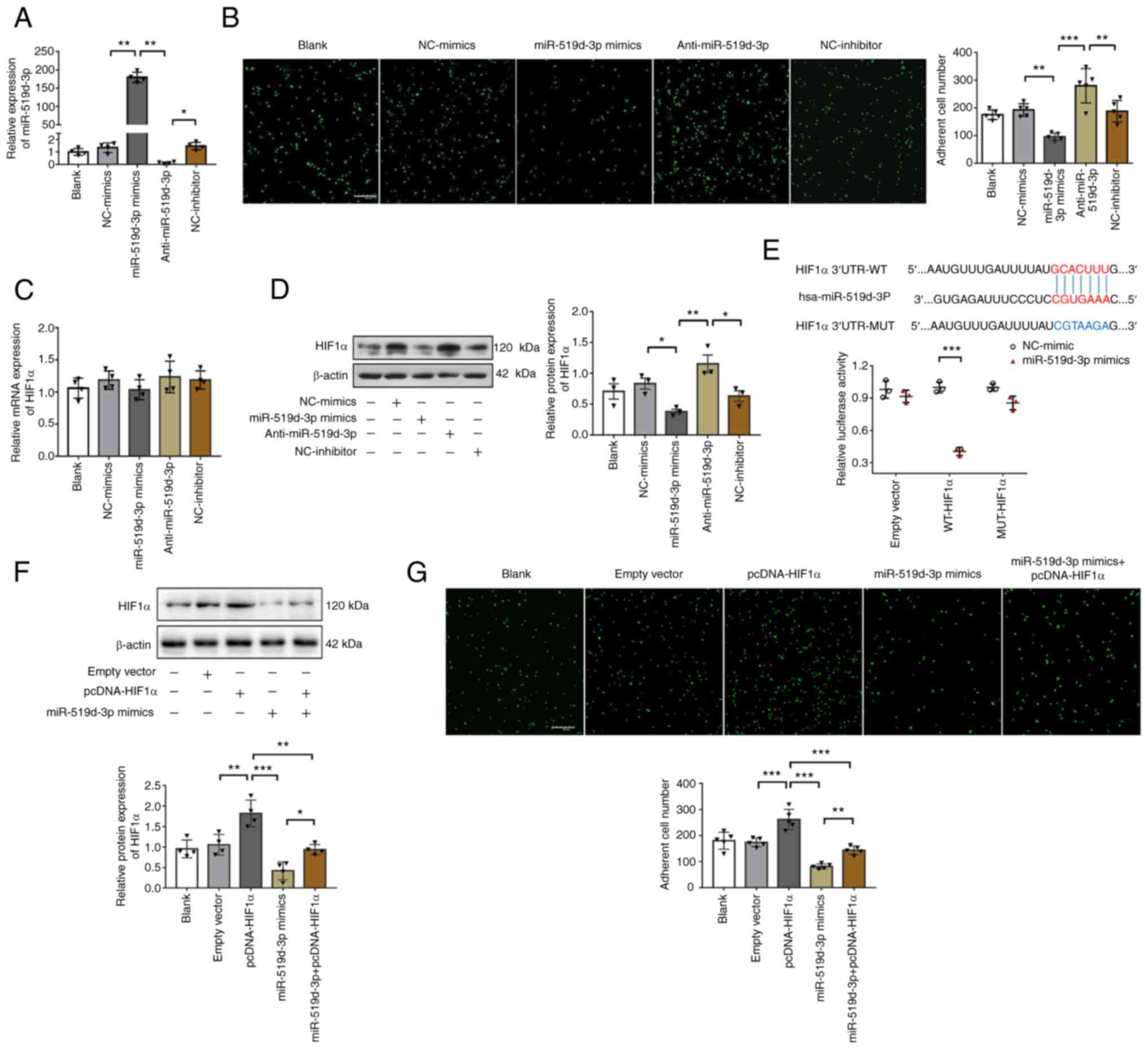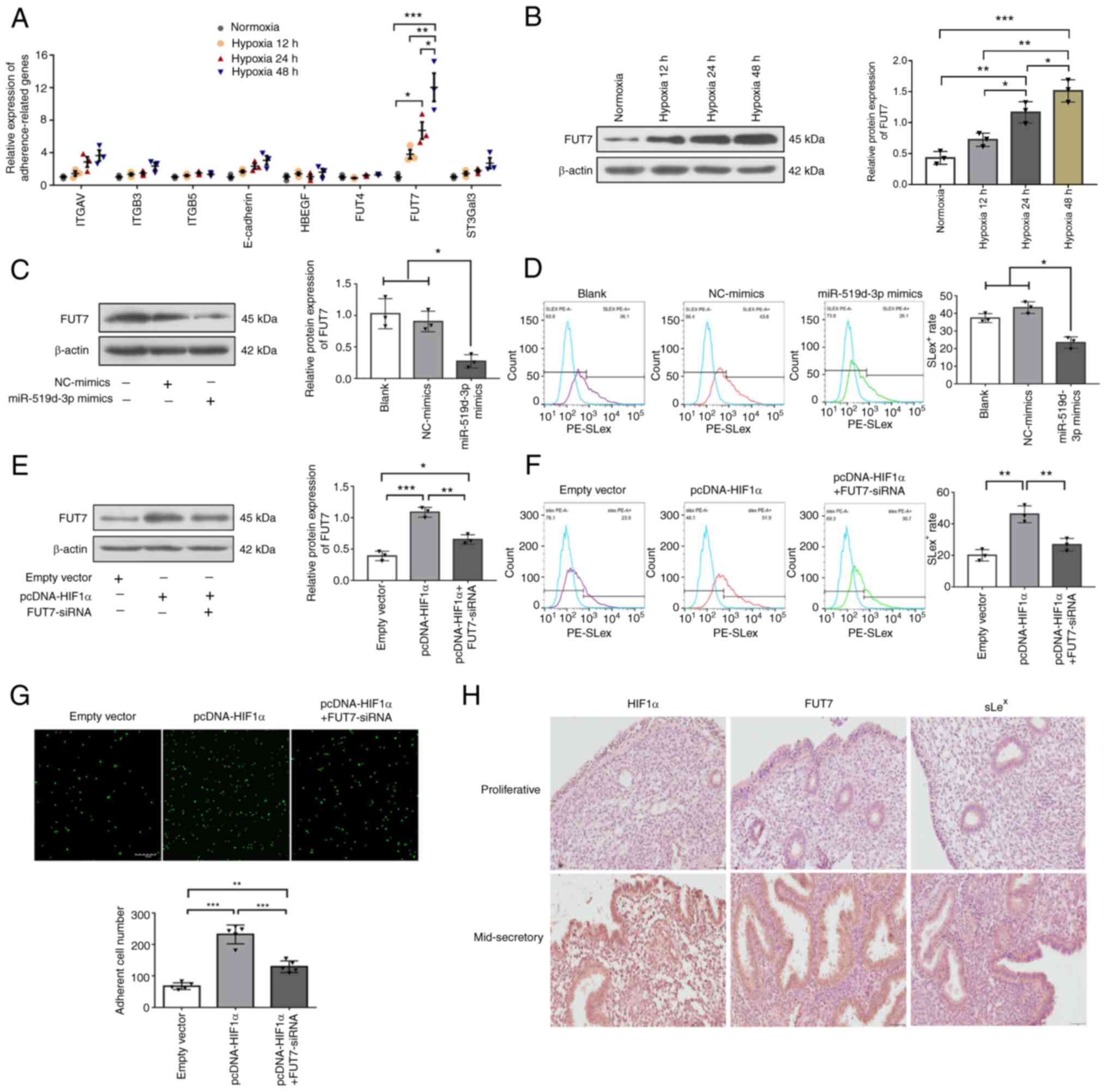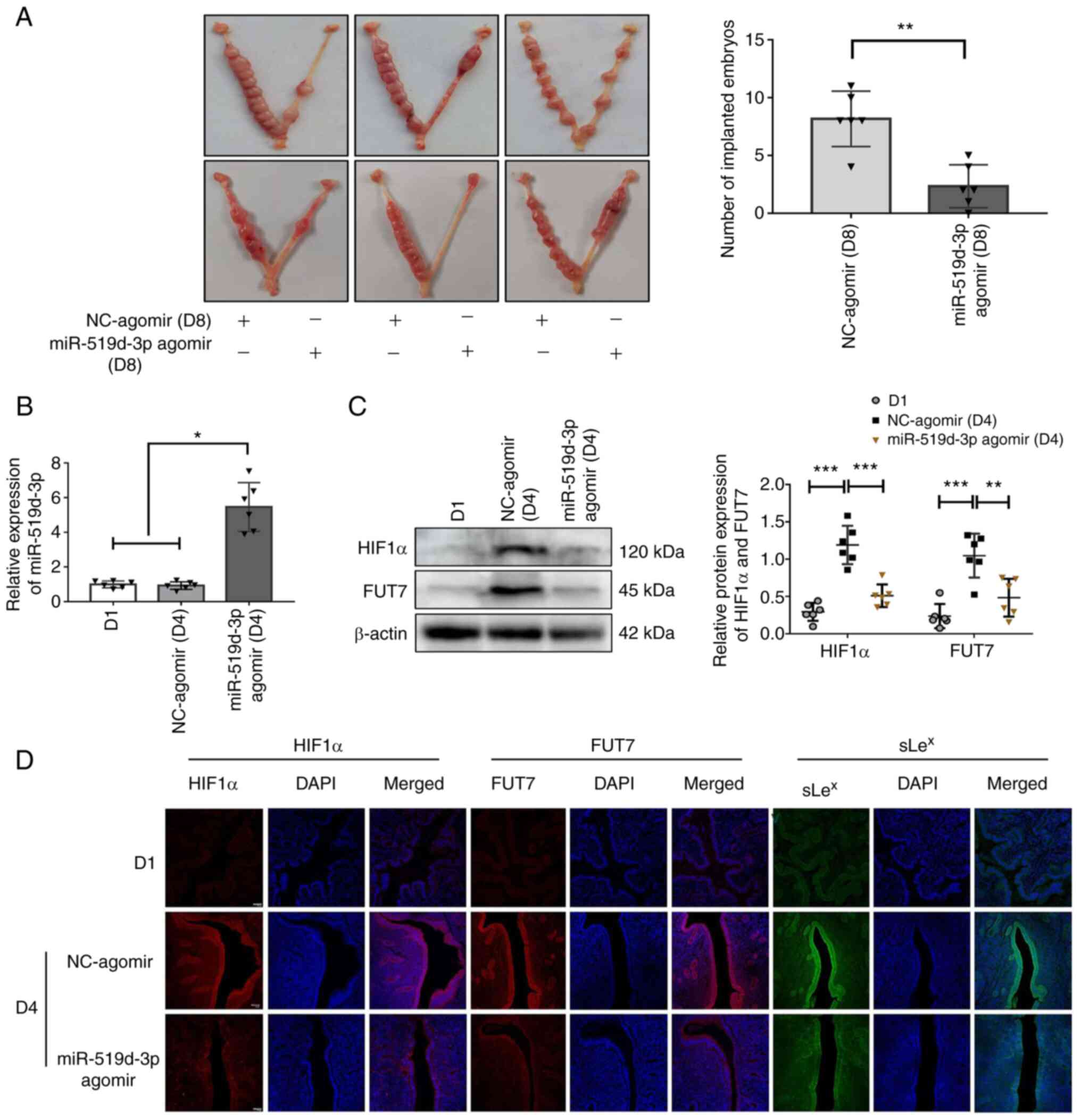|
1
|
Saha S, Roy P, Corbitt C and Kakar SS:
Application of stem cell therapy for infertility. Cells.
10:1613–1638. 2021. View Article : Google Scholar : PubMed/NCBI
|
|
2
|
Ata B, Kalafat E and Somigliana E: A new
definition of recurrent implantation failure on the basis of
anticipated blastocyst aneuploidy rates across female age. Fertil
Steril. 116:1320–1327. 2021. View Article : Google Scholar : PubMed/NCBI
|
|
3
|
Carson DD, Bagchi I, Dey SK, Enders AC,
Fazleabas AT, Lessey BA and Yoshinaga K: Embryo implantation. Dev
Biol. 223:217–237. 2000. View Article : Google Scholar : PubMed/NCBI
|
|
4
|
Norwitz ER, Schust DJ and Fisher SJ:
Implantation and the survival of early pregnancy. N Engl J Med.
345:1400–1408. 2001. View Article : Google Scholar
|
|
5
|
Modi DN and Bhartiya P: Physiology of
embryo-endometrial cross talk. Biomed Res J. 2:83–104. 2015.
|
|
6
|
Simon C, Gimeno MJ, Mercader A, O'Connor
JE, Remohi J, Polan ML and Pellicer A: Embryonic regulation of
Integrins b3, a4, and a1 in human endometrial epithelial cells in
vitro. J Clin Endocrinol Metab. 82:2607–2616. 1997.
|
|
7
|
Vilella F, Moreno-Moya JM, Balaguer N,
Grasso A, Herrero M, Martinez S, Marcilla A and Simon C:
Hsa-miR-30d, secreted by the human endometrium, is taken up by the
pre-implantation embryo and might modify its transcriptome.
Development. 142:3210–3221. 2015. View Article : Google Scholar : PubMed/NCBI
|
|
8
|
Giglio S, De Nunzio C, Cirombella R,
Stoppacciaro A, Faruq O, Volinia S, Baldassarre G, Tubaro A, Ishii
H, Croce CM and Vecchione A: A preliminary study of micro-RNAs as
minimally invasive biomarkers for the diagnosis of prostate cancer
patients. J Exp Clin Cancer Res. 40:792021. View Article : Google Scholar : PubMed/NCBI
|
|
9
|
Sanchez-Ceinos J, Rangel-Zuniga OA,
Clemente-Postigo M, Podadera-Herreros A, Camargo A, Alcala-Diaz JF,
Guzman-Ruiz R, Lopez-Miranda J and Malagon MM: miR-223-3p as a
potential biomarker and player for adipose tissue dysfunction
preceding type 2 diabetes onset. Mol Ther Nucleic Acids.
23:1035–1052. 2021. View Article : Google Scholar :
|
|
10
|
Yamada NO and Senda T: Circulating
microRNA-92a-3p in colorectal cancer: A review. Med Mol Morphol.
54:193–202. 2021. View Article : Google Scholar : PubMed/NCBI
|
|
11
|
Mori MA, Ludwig RG, Garcia-Martin R,
Brandao BB and Kahn CR: Extracellular miRNAs: From biomarkers to
mediators of physiology and disease. Cell Metab. 30:656–673. 2019.
View Article : Google Scholar : PubMed/NCBI
|
|
12
|
Zhou W and Dimitriadis E: Secreted
MicroRNA to predict embryo implantation outcome: From research to
clinical diagnostic application. Front Cell Dev Biol. 8:5865102020.
View Article : Google Scholar : PubMed/NCBI
|
|
13
|
Bridi A, Andrade GM, Del Collado M,
Sangalli JR, de Avila A, Motta IG, da Silva JCB, Pugliesi G, Silva
LA, Meirelles FV, et al: Small extracellular vesicles derived from
in vivo- or in vitro-produced bovine blastocysts have different
miRNAs profiles-Implications for embryo-maternal recognition. Mol
Reprod Dev. 88:628–643. 2021. View Article : Google Scholar : PubMed/NCBI
|
|
14
|
Cuman C, Van Sinderen M, Gantier MP,
Rainczuk K, Sorby K, Rombauts L, Osianlis T and Dimitriadis E:
Human blastocyst secreted microRNA regulate endometrial epithelial
cell adhesion. EBioMedicine. 2:1528–1535. 2015. View Article : Google Scholar : PubMed/NCBI
|
|
15
|
Cimadomo D, Rienzi L, Giancani A, Alviggi
E, Dusi L, Canipari R, Noli L, Ilic D, Khalaf Y, Ubaldi FM and
Capalbo A: Definition and validation of a custom protocol to detect
miRNAs in the spent media after blastocyst culture: Searching for
biomarkers of implantation. Hum Reprod. 34:1746–1761. 2019.
View Article : Google Scholar : PubMed/NCBI
|
|
16
|
Capalbo A, Ubaldi FM, Cimadomo D, Noli L,
Khalaf Y, Farcomeni A, Ilic D and Rienzi L: MicroRNAs in spent
blastocyst culture medium are derived from trophectoderm cells and
can be explored for human embryo reproductive competence
assessment. Fertil Steril. 105:225–235. e1–3. 2016. View Article : Google Scholar
|
|
17
|
Paquette AG, Chu T, Wu X, Wang K, Price ND
and Sadovsky Y: Distinct communication patterns of trophoblastic
miRNA among the maternal-placental-fetal compartments. Placenta.
72-73:28–35. 2018. View Article : Google Scholar : PubMed/NCBI
|
|
18
|
Delorme-Axford E, Donker RB, Mouillet JF,
Chu T, Bayer A, Ouyang Y, Wang T, Stolz DB, Sarkar SN, Morelli AE,
et al: Human placental trophoblasts confer viral resistance to
recipient cells. Proc Natl Acad Sci USA. 110:12045–12053. 2013.
View Article : Google Scholar
|
|
19
|
Jing J, Wang Y, Quan Y, Wang Z, Liu Y and
Ding Z: Maternal obesity alters C19MC microRNAs expression profile
in fetal umbilical cord blood. Nutr Metab (Lund). 17:522020.
View Article : Google Scholar
|
|
20
|
Kambe S, Yoshitake H, Yuge K, Ishida Y,
Ali MM, Takizawa T, Kuwata T, Ohkuchi A, Matsubara S, Suzuki M, et
al: Human exosomal placenta-associated miR-517a-3p modulates the
expression of PRKG1 mRNA in Jurkat cells1. Biol Reprod. 91:1292014.
View Article : Google Scholar
|
|
21
|
Chaiwangyen W, Murrieta-Coxca JM, Favaro
RR, Photini SM, Gutiérrez-Samudio RN, Schleussner E, Markert UR and
Morales-Prieto DM: MiR-519d-3p in trophoblastic cells: Effects,
targets and transfer to allogeneic immune cells via extracellular
vesicles. Int J Mol Sci. 21:34582020. View Article : Google Scholar :
|
|
22
|
Morales-Prieto DM, Ospina-Prieto S,
Chaiwangyen W, Schoenleben M and Markert UR: Pregnancy-associated
miRNA-clusters. J Reprod Immunol. 97:51–61. 2013. View Article : Google Scholar : PubMed/NCBI
|
|
23
|
Gardner DK and Lane M: Culture and
selection of viable blastocysts: A feasible proposition for human
IVF? Hum Reprod Update. 3:367–382. 1997. View Article : Google Scholar : PubMed/NCBI
|
|
24
|
Livak KJ and Schmittgen TD: Analysis of
relative gene expression data using real-time quantitative PCR and
the 2(-Delta Delta C(T)) method. Methods. 25:402–408. 2001.
View Article : Google Scholar
|
|
25
|
Zhou J, Li YS, Nguyen P, Wang KC, Weiss A,
Kuo YC, Chiu JJ, Shyy JY and Chien S: Regulation of vascular smooth
muscle cell turnover by endothelial cell-secreted microRNA-126:
Role of shear stress. Circ Res. 113:40–51. 2013. View Article : Google Scholar : PubMed/NCBI
|
|
26
|
Giacomini E, Vago R, Sanchez AM, Podini P,
Zarovni N, Murdica V, Rizzo R, Bortolotti D, Candiani M and Viganò
P: Secretome of in vitro cultured human embryos contains
extracellular vesicles that are uptaken by the maternal side. Sci
Rep. 7:52102017. View Article : Google Scholar : PubMed/NCBI
|
|
27
|
National Research Council (US) Committee
for the Update of the Guide for the Care and Use of Laboratory
Animals: Guide for the Care and Use of Laboratory Animals: Guide
for the Care and Use of Laboratory Animals. 8:National Academies
Press (US); Washington, DC: 2011, https://grants.nih.gov/grants/olaw/Guide-for-the-Care-and-use-of-laboratory-animals.pdf.
|
|
28
|
Abu-Halima M, Häusler S, Backes C,
Fehlmann T, Staib C, Nestel S, Nazarenko I, Meese E and Keller A:
Micro-ribonucleic acids and extracellular vesicles repertoire in
the spent culture media is altered in women undergoing in vitro
fertilization. Sci Rep. 7:135252017. View Article : Google Scholar : PubMed/NCBI
|
|
29
|
Gross N, Kropp J and Khatib H: Sexual
dimorphism of miRNAs secreted by bovine in vitro-produced embryos.
Front Genet. 8:392017. View Article : Google Scholar :
|
|
30
|
Fischer B and Bavister BD: Oxygen tension
in the oviduct and uterus of rhesus monkeys, hamsters and rabbits.
J Reprod Fertil. 99:673–679. 1993. View Article : Google Scholar : PubMed/NCBI
|
|
31
|
Salman MM, Kitchen P, Woodroofe MN, Bill
RM, Conner AC, Heath PR and Conner MT: Transcriptome analysis of
gene expression provides new insights into the effect of mild
therapeutic hypothermia on primary human cortical astrocytes
cultured under hypoxia. Front Cell Neurosci. 11:386–400. 2017.
View Article : Google Scholar
|
|
32
|
Daikoku T, Matsumoto H, Gupta RA, Das SK,
Gassmann M, DuBois RN and Dey SK: Expression of hypoxia-inducible
factors in the peri-implantation mouse uterus is regulated in a
cell-specific and ovarian steroid hormone-dependent manner.
Evidence for differential function of HIFs during early pregnancy.
J Biol Chem. 278:7683–7691. 2003. View Article : Google Scholar
|
|
33
|
Chen X, Jiang L, Wang CC, Huang J and Li
TC: Hypoxia inducible factor and microvessels in peri-implantation
endometrium of women with recurrent miscarriage. Fertil Steril.
105:1496–1502.e4. 2016. View Article : Google Scholar : PubMed/NCBI
|
|
34
|
Yu X, Gao C, Dai C, Yang F and Deng X:
Endometrial injury increases expression of hypoxia-inducible factor
and angiogenesis in the endometrium of women with recurrent
implantation failure. Reprod Biomed Online. 38:761–767. 2019.
View Article : Google Scholar : PubMed/NCBI
|
|
35
|
Rarani FZ, Borhani F and Rashidi B:
Endometrial pinopode biomarkers: Molecules and microRNAs. J Cell
Physiol. 233:9145–9158. 2018. View Article : Google Scholar : PubMed/NCBI
|
|
36
|
Koot YE, Teklenburg G, Salker MS, Brosens
JJ and Macklon NS: Molecular aspects of implantation failure.
Biochim Biophys Acta. 1822:1943–1950. 2012. View Article : Google Scholar : PubMed/NCBI
|
|
37
|
Zheng Q, Zhang D, Yang YU, Cui X, Sun J,
Liang C, Qin H, Yang X, Liu S and Yan Q: MicroRNA-200c impairs
uterine receptivity formation by targeting FUT4 and
alpha1,3-fucosylation. Cell Death Differ. 24:2161–2172. 2017.
View Article : Google Scholar : PubMed/NCBI
|
|
38
|
Genbacev OD, Prakobphol A, Foulk RA,
Krtolica AR, Ilic D, Singer MS, Yang ZQ, Kiessling LL, Rosen SD and
Fisher SJ: Trophoblast L-selectin-mediated adhesion at the
maternal-fetal interface. Science. 299:405–408. 2003. View Article : Google Scholar : PubMed/NCBI
|
|
39
|
Yu M, Wang H, Liu J, Qin H, Liu S and Yan
Q: The sialyltransferase ST3Gal3 facilitates the receptivity of the
uterine endometrium in vitro and in vivo. FEBS Lett. 592:3696–3707.
2018. View Article : Google Scholar : PubMed/NCBI
|
|
40
|
Rosenbluth EM, Shelton DN, Wells LM,
Sparks AE and Van Voorhis BJ: Human embryos secrete microRNAs into
culture media-a potential biomarker for implantation. Fertil
Steril. 101:1493–1500. 2014. View Article : Google Scholar : PubMed/NCBI
|
|
41
|
Borges E Jr, Setti AS, Braga DP, Geraldo
MV, Figueira RC and Iaconelli A Jr: miR-142-3p as a biomarker of
blastocyst implantation failure-A pilot study. JBRA Assist Reprod.
20:200–205. 2016. View Article : Google Scholar
|
|
42
|
Sanchez-Ribas I, Diaz-Gimeno P, Quinonero
A, Ojeda M, Larreategui Z, Ballesteros A and Dominguez F: NGS
analysis of human embryo culture media reveals miRNAs of extra
embryonic origin. Reprod Sci. 26:214–222. 2019. View Article : Google Scholar
|
|
43
|
Heidari F, Hosseini S, Yeganeh SM and
Salehi M: Expression of miR-Let-7a, miR-15a, miR-16-1 and their
target genes in fresh and vitrified embryos and its surrounding
culture media for noninvasive embryo assessment. J Cell Biochem.
120:19691–19698. 2019. View Article : Google Scholar : PubMed/NCBI
|
|
44
|
Russell SJ, Menezes K, Balakier H and
Librach C: Comprehensive profiling of Small RNAs in human
embryo-conditioned culture media by improved sequencing and
quantitative PCR methods. Syst Biol Reprode Med. 66:129–139. 2020.
View Article : Google Scholar
|
|
45
|
Fang F, Li Z, Yu J, Long Y, Zhao Q, Ding
X, Wu L, Shao S, Zhang L and Xiang W: MicroRNAs secreted by human
embryos could be potential biomarkers for clinical outcomes of
assisted reproductive technology. J Adv Res. 31:25–34. 2021.
View Article : Google Scholar : PubMed/NCBI
|
|
46
|
Rio PD and Madan P: Does miRNA Expression
in the spent media change during early embryo development? Front
Vet Sci. 8:6589682021. View Article : Google Scholar : PubMed/NCBI
|
|
47
|
Khan HL, Bhatti S, Abbas S, Kaloglu C, Isa
AM, Younas H, Ziders R, Khan YL, Hassan Z, Turhan BO, et al:
Extracellular microRNAs: Key players to explore the outcomes of in
vitro fertilization. Reprod Biol Endocrinol. 19:722021. View Article : Google Scholar : PubMed/NCBI
|
|
48
|
Hawke DC, Ahmed DB, Watson AJ and Betts
DH: Murine blastocysts release mature microRNAs into culture media
that reflect developmental status. Front Genet. 12:6558822021.
View Article : Google Scholar : PubMed/NCBI
|
|
49
|
Rosenbluth EM, Shelton DN, Sparks AET,
Devor E, Christenson L and Van Voorhis BJ: MicroRNA expression in
the human blastocyst. Fertil Steril. 99:855–861.e3. 2013.
View Article : Google Scholar
|
|
50
|
Tkach M and Théry C: Communication by
extracellular vesicles: Where we are and where we need to go. Cell.
164:1226–1232. 2016. View Article : Google Scholar : PubMed/NCBI
|
|
51
|
Kurian NK and Modi D: Extracellular
vesicle mediated embryo-endometrial cross talk during implantation
and in pregnancy. J Assist Reprod Genet. 36:189–198. 2019.
View Article : Google Scholar :
|
|
52
|
Giacomini E, Makieva S, Murdica V, Vago R
and Vigano P: Extracellular vesicles as a potential diagnostic tool
in assisted reproduction. Curr Opin Obstet Gynecol. 32:179–184.
2020. View Article : Google Scholar : PubMed/NCBI
|
|
53
|
Lin S, Cheung WK, Chen S, Lu G, Wang Z,
Xie D, Li K, Lin MC and Kung HF: Computational identification and
characterization of primate-specific microRNAs in human genome.
Comput Biol Chem. 34:232–241. 2010. View Article : Google Scholar : PubMed/NCBI
|
|
54
|
Liang Y, Ridzon D, Wong L and Chen C:
Characterization of microRNA expression profiles in normal human
tissues. BMC Genomics. 8:1662007. View Article : Google Scholar : PubMed/NCBI
|
|
55
|
Dumont TMF, Mouillet JF, Bayer A, Gardner
CL, Klimstra WB, Wolf DG, Yagel S, Balmir F, Binstock A, Sanfilippo
JS, et al: The expression level of C19MC miRNAs in early pregnancy
and in response to viral infection. Placenta. 53:23–29. 2017.
View Article : Google Scholar : PubMed/NCBI
|
|
56
|
Xie L, Mouillet JF, Chu T, Parks WT,
Sadovsky E, Knofler M and Sadovsky Y: C19MC microRNAs regulate the
migration of human trophoblasts. Endocrinology. 155:4975–4985.
2014. View Article : Google Scholar : PubMed/NCBI
|
|
57
|
Hromadnikova I, Kotlabova K, Ivankova K
and Krofta L: Expression profile of C19MC microRNAs in placental
tissue of patients with preterm prelabor rupture of membranes and
spontaneous preterm birth. Mol Med Rep. 16:3849–3862. 2017.
View Article : Google Scholar : PubMed/NCBI
|
|
58
|
Hromadnikova I, Kotlabova K, Ivankova K
and Krofta L: First trimester screening of circulating C19MC
microRNAs and the evaluation of their potential to predict the
onset of preeclampsia and IUGR. PLoS One. 12:e01717562017.
View Article : Google Scholar : PubMed/NCBI
|
|
59
|
Hromadnikova I, Dvorakova L, Kotlabova K
and Krofta L: The prediction of gestational hypertension,
preeclampsia and fetal growth restriction via the first trimester
screening of plasma exosomal C19MC microRNAs. Int J Mol Sci.
20:29722019. View Article : Google Scholar :
|
|
60
|
Wommack JC, Trzeciakowski JP, Miranda RC,
Stowe RP and Ruiz RJ: Micro RNA clusters in maternal plasma are
associated with preterm birth and infant outcomes. PLoS One.
13:e01990292018. View Article : Google Scholar : PubMed/NCBI
|
|
61
|
Semenza GL: Regulation of mammalian O2
homeostasis by hypoxia-inducible factor 1. Annu Rev Cell Dev Biol.
15:551–578. 1999. View Article : Google Scholar : PubMed/NCBI
|
|
62
|
Salman MM, Kitchen P, Halsey A, Wang MX,
Törnroth-Horsefield S, Conner AC, Badaut J, Iliff JJ and Bill RM:
Emerging roles for dynamic aquaporin-4 subcellular relocalization
in CNS water homeostasis. Brain. 145:64–75. 2022. View Article : Google Scholar :
|
|
63
|
Salman MM, Kitchen P, Yool AJ and Bill RM:
Recent breakthroughs and future directions in drugging aquaporins.
Trends Pharmacol Sci. 43:30–42. 2022. View Article : Google Scholar
|
|
64
|
Semenza GL: HIF-1: Mediator of
physiological and pathophysiological responses to hypoxia. J Appl
Physiol (1985). 88:1474–1480. 2000. View Article : Google Scholar
|
|
65
|
Zhao DM: Analysis of pregnancy outcomes in
obese-women with PCOS after IVF-ET and effects of hypoxia-inducible
factor-1a on endometrial receptivity of them (unpublished PhD
thesis). Shandong University School of Medicine; 2018
|
|
66
|
Ujvari D, Jakson I, Oldmark C, Attarha S,
Alkasalias T, Salamon D, Gidlöf S and Hirschberg AL: Prokineticin 1
is up-regulated by insulin in decidualizing human preendometrial
stromal cells. J Cell Mol Med. 22:163–172. 2018. View Article : Google Scholar
|
|
67
|
Aplin JD and Jones CJ: Fucose, placental
evolution and the glycocode. Glycobiology. 22:470–478. 2012.
View Article : Google Scholar
|
|
68
|
Zhang Y, Liu S, Liu Y, Wang Z, Wang X and
Yan Q: Overexpression of fucosyltransferase VII (FUT7) promotes
embryo adhesion and implantation. Fertil Steril. 91:908–914. 2009.
View Article : Google Scholar
|
|
69
|
Jin F and Wang F: The physiological and
pathological roles and applications of sialyl Lewis x, a common
carbohydrate ligand of the three selectins. Glycoconj J.
37:277–291. 2020. View Article : Google Scholar : PubMed/NCBI
|
|
70
|
Li DS, Sun HZ, Bai G, Wang W, Liu MM, Bao
ZY, Li JJ and Liu H: α-1,3-Fucosyltransferase-VII siRNA inhibits
the expression of SLex and hepatocarcinoma cell proliferation. Int
J Mol Med. 42:2700–2708. 2018.PubMed/NCBI
|
|
71
|
Wang B, Sheng JZ, He RH, Qian YL, Jin F
and Huang HF: ORIGINAL ARTICLE: High expression of l-selectin
ligand in secretory endometrium is associated with better
endometrial receptivity and facilitates embryo implantation in
human being. Am J Reprod Immunol. 60:127–134. 2008. View Article : Google Scholar : PubMed/NCBI
|
|
72
|
Foulk RA, Zdravkovic T, Genbacev O and
Prakobphol A: Expression of L-selectin ligand MECA-79 as a
predictive marker of human uterine receptivity. J Assist Reprod
Genet. 24:316–321. 2007. View Article : Google Scholar : PubMed/NCBI
|















